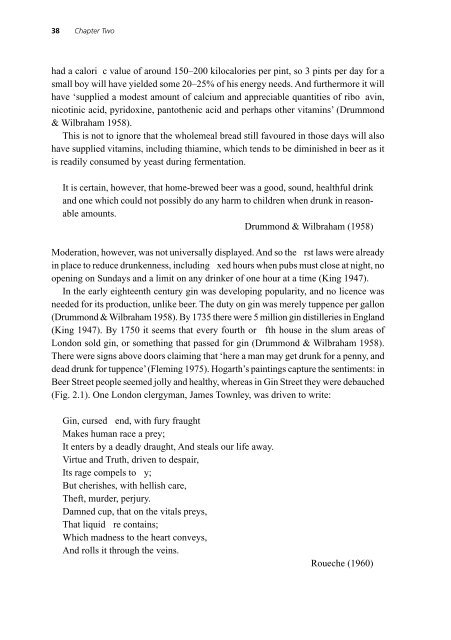Beer : Health and Nutrition
Beer : Health and Nutrition
Beer : Health and Nutrition
You also want an ePaper? Increase the reach of your titles
YUMPU automatically turns print PDFs into web optimized ePapers that Google loves.
38 Chapter Two<br />
had a calori c value of around 150–200 kilocalories per pint, so 3 pints per day for a<br />
small boy will have yielded some 20–25% of his energy needs. And furthermore it will<br />
have ‘supplied a modest amount of calcium <strong>and</strong> appreciable quantities of ribo avin,<br />
nicotinic acid, pyridoxine, pantothenic acid <strong>and</strong> perhaps other vitamins’ (Drummond<br />
& Wilbraham 1958).<br />
This is not to ignore that the wholemeal bread still favoured in those days will also<br />
have supplied vitamins, including thiamine, which tends to be diminished in beer as it<br />
is readily consumed by yeast during fermentation.<br />
It is certain, however, that home-brewed beer was a good, sound, healthful drink<br />
<strong>and</strong> one which could not possibly do any harm to children when drunk in reasonable<br />
amounts.<br />
Drummond & Wilbraham (1958)<br />
Moderation, however, was not universally displayed. And so the rst laws were already<br />
in place to reduce drunkenness, including xed hours when pubs must close at night, no<br />
opening on Sundays <strong>and</strong> a limit on any drinker of one hour at a time (King 1947).<br />
In the early eighteenth century gin was developing popularity, <strong>and</strong> no licence was<br />
needed for its production, unlike beer. The duty on gin was merely tuppence per gallon<br />
(Drummond & Wilbraham 1958). By 1735 there were 5 million gin distilleries in Engl<strong>and</strong><br />
(King 1947). By 1750 it seems that every fourth or fth house in the slum areas of<br />
London sold gin, or something that passed for gin (Drummond & Wilbraham 1958).<br />
There were signs above doors claiming that ‘here a man may get drunk for a penny, <strong>and</strong><br />
dead drunk for tuppence’ (Fleming 1975). Hogarth’s paintings capture the sentiments: in<br />
<strong>Beer</strong> Street people seemed jolly <strong>and</strong> healthy, whereas in Gin Street they were debauched<br />
(Fig. 2.1). One London clergyman, James Townley, was driven to write:<br />
Gin, cursed end, with fury fraught<br />
Makes human race a prey;<br />
It enters by a deadly draught, And steals our life away.<br />
Virtue <strong>and</strong> Truth, driven to despair,<br />
Its rage compels to y;<br />
But cherishes, with hellish care,<br />
Theft, murder, perjury.<br />
Damned cup, that on the vitals preys,<br />
That liquid re contains;<br />
Which madness to the heart conveys,<br />
And rolls it through the veins.<br />
Roueche (1960)

















